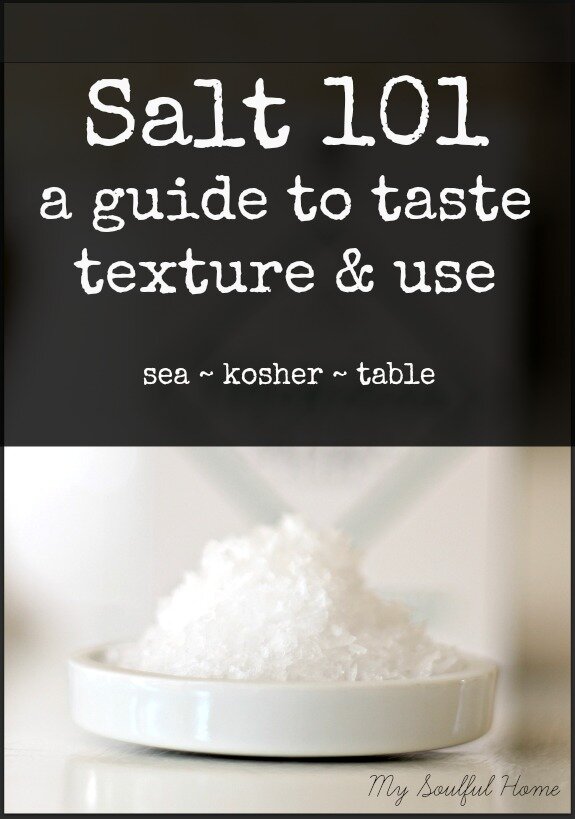Salt 101 - A Guide to Sea, Kosher & Table
Unless you are a real foodie, salt may be one of those taken for granted, not given too much thought things.
However, understanding the differences & best uses for each type of salt can really up your game in the kitchen.
So I am here to fill you in…shake out the facts, sprinkle on some details and add a pinch of history…to get you rockin' in the kitchen.

Guide to Salt - Sea, Kosher & Table
The most notable differences between sea, kosher and table salt are in their processing, texture and taste. These differences dictate which to use for what purpose.
 Sea Salt:
Sea Salt:
Sea salt, also referred to as finishing salt, is produced through evaporation of ocean water or saltwater lakes, with little or no processing. Depending on the water source, different minerals are left behind. These minerals add flavor and color.
Sea Salt comes in a variety of textures. There are crystalline sea salts made of irregular shaped crystals from fine to coarse. Also, flaked sea salts which are soft, sheer & pyramid shaped.
The taste of sea salts are bright & clean, with subtle flavor depending on the minerals left behind.
Use sea salt is as a finishing salt. Sprinkle it, or in the case of flakes crush it between your fingers and then sprinkle, on cooked foods, salads or even desserts. Doing so will add a vibrancy, enhancing any dish.
Examples of sea salts are:
- Fleur de Sel - crystalline
- Hawaiian Sea Salt - crystalline
- Maldon - flake
 Kosher Salt:
Kosher Salt:
Kosher salt is harvested by either evaporation or from mining the earth. There is minimal processing with either method.
Hallmarked by large irregular coarse flakes, that dissolve & disperse quickly, kosher salt is recommended for all types of cooking.
The flavor of kosher salt is the least "salty".
Because the flakes are large they retain moisture. This makes Kosher salt perfect for curing meats. In fact, kosher salt got its name because salting meat is a step in the koshering process. Interesting, huh?
Salting meat in kosher salt before cooking will ensure it to be tender & juicy. As the salt holds the moisture inside the meat.
Use kosher salt in a recipe if it calls specifically for it whenever possible. If you can't - NOTE: a tablespoon of Kosher salt = a teaspoon of table salt.

Table Salt:
Table salt is mined from underground salt deposits. Table salt is heavily processed to eliminate minerals, bleached and usually contains an additive to prevent clumping.
Most table salt also has added iodine, an essential nutrient that helps maintain a healthy thyroid.
The addition of iodine began during the Depression. In response to the easily preventable thyroid illnesses becoming prevalent due to the shortage of food, the government & salt companies joined forces to supplement the salt with iodine. This practice continues today. I told you there would be some history...
Pure sodium chloride, table salt, is bland, bitter, the "saltiest" & lacks the potential benefits of the minerals contained in the other types of salt. But this salt has a place at your table - or better yet your counter. Put the sea salt on your table!
Use table salt to salt your pasta, potato water and other utilitarian purposes in the kitchen.
So there is the scoop on salt. Want to know my favorite?

Maldon, flakes. Barely anything leaves my kitchen without a sprinkling of those sparkly flakes.
Want to try Maldon for yourself? Good, 'cause I want to give you a box!
Leave me a comment about a person you know who fits the phrase "the salt of the earth". You'll be entered to win a box of Maldon.
** Kelly **
( winner randomly selected on 2/1 )

